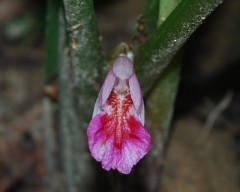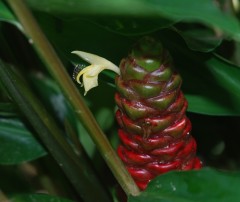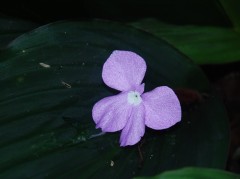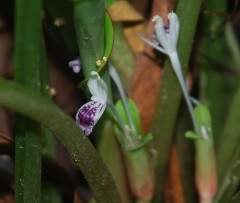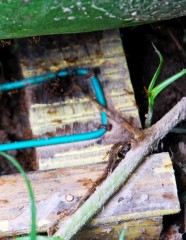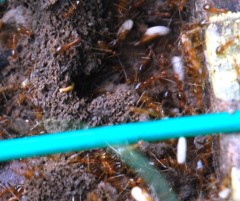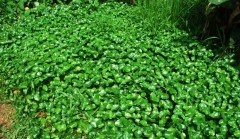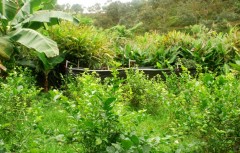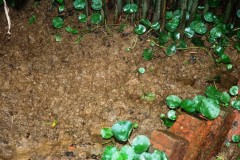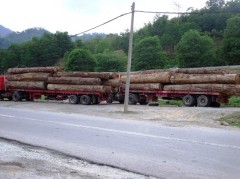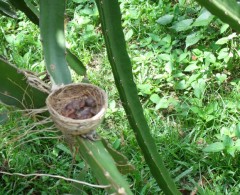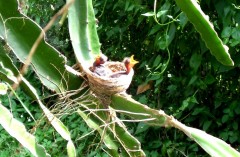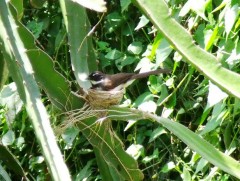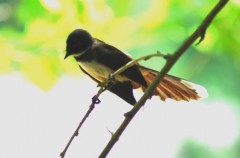Jul 16, 2010
Emerald Doves came visiting
There was a flutter and a flash of iridescent green darting up from the ground towards some thick low branches. I thought I saw a pair of pigeon.
I approached the branches slowly and they darted off again to a clump of kantan and then were gone.
I knew then that they were a pair of punai tanah or Emerald Dove (chalcophaps indica indica). They were flighty, as are most first timers (birds I mean) to the farm. Nonetheless it is great that this pair of young adults have come down from the rainforest to the farm. Hopefully they will nest here.
Emerald doves in Malaysia are shy and flighty, possibly due to over hunting. It is an honour that this pair feel secure enough to visit us.
Here's a photo I downloaded from Lip Kee's photostream at Flickr.

Readers, should you decide to use this picture, please accept the terms of use at Lip Kee's page at Flickr. It is the right thing to do (I have found my pics and writings in odd places without attribution and it is annoying to say the least).
The incident with the pigeons happened so fast, I did not have the chance to get my camera. In any event without a good telephoto lens I would not be able to capture them. Time to invest in a 400mm lens at least, I suppose. That will set me back a few thousand ringgit. Maybe next year.
11:14 Posted in Blog | Permalink | Comments (0) | Tags: chalcophaps indica indica, emerald dove, wild pigeon, punai, punai tanah
Jun 28, 2010
Flowers of the ginger family at the farm
Wild gingers have lovely flowers seldom seen.
Some of the wild gingers planted at our farm are flowering (click on pics for enlarged image).
11:29 Posted in Blog | Permalink | Comments (3) | Tags: boesenbergia rotunda, black turmeric, curcuma longa, kaempferia galangal var, zingziber zerumbet, kunyit hitam, cekur, kunyit putih, lempoyang
Jun 15, 2010
Sanctuary for butterflies
The Raja Brooke's Birdwings (Trogonoptera Brookiana) are gone from the waterfall. What a difference a week makes. The clearing works at the side of the falls and further up have destroyed their habitat. All the aristolochia foveolata, their host plant, have been slashed as the undergrowth was cleared.
This is a photo we took of them in September last year at the banks of the falls (the smaller one is a Common Jay) :
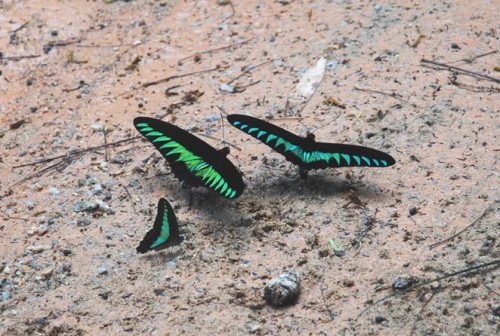
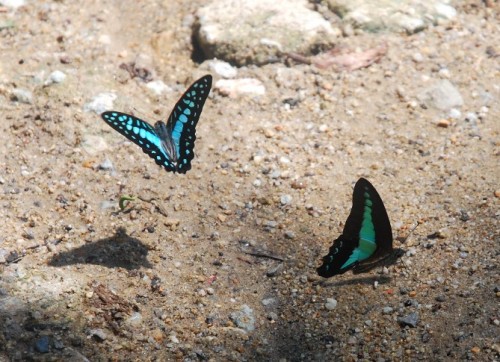
19:13 Posted in Blog | Permalink | Comments (0) | Tags: raja brooke's, birdwing butterflies, common jay, trogonoptera brookiana, aristolochia foveolata
Jun 10, 2010
Uncertainty...
The low clouds made me contemplative, sitting by that waterfall. Reminiscing that long train ride to Brockenhurst on a damp autumn day. And alone in a stark rented apartment a different life ago, overlooking Tower Bridge; anxiously waiting.... And having cheap ice cream for lunch and dinner.
Then there was a barely perceptible change in the air. An urgency in the breeze; a quickening in the mood of the birds that surrounded me and the Raja Brookes all suddenly took off.
Then a roar, and a wall of water came towards me...
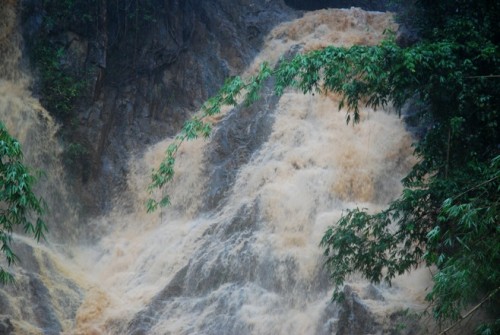
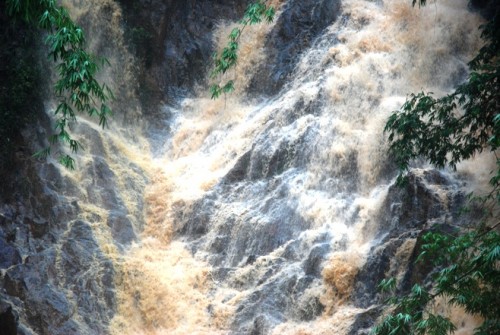
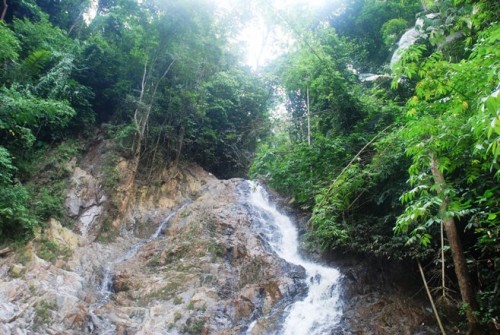
15:19 Posted in Blog | Permalink | Comments (2) | Tags: flash floods, runoffs, soil infiltration, clearing forests
May 19, 2010
Proud Farmer II
Around the Klang Valley are literally hundreds of small farms producing vegetables and fruits for the insatiable appetite of city residents.
These farms are mainly unsupervised and are farmed mostly by immigrants, legal or otherwise. Buyers will come and load up and take them to the wholesale markets. At the wholesale markets, retailers will come to cart off their selections to sell them at pasar malam(s), stalls and other retail outlets.
Smaller buyers will come to the farms too, to buy and sell them to nearby restaurants where you have your weekend holiday meals (for the 'freshness' of the meats and vegetables).
We decided to visit one such farm situated right next to a stream feeding a river further down. The farmer is very proud of his produce which looks appetizing, fresh, healthy with no insect or fungal damage. It is sold at nearby restaurants and also taken to the main wholesale market in the Klang Valley.
The farm is situated in a picturesque location where senior government and corporate officials often come to take their break or to attend seminars and training courses.

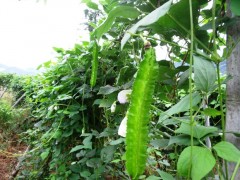


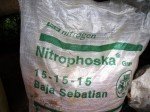
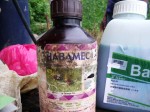
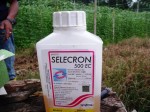
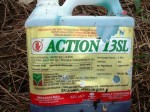
He explains that he sprays the vegetables with insecticides every 3 days right up to harvest.
He gave us some samples to take back.
The vegetables reek.
Note:
The farmer is illiterate.
One of the chemicals he uses is a paraquat. Just two teaspoons of paraquat will kill a man. Read here on paraquat.
The insecticide he uses every 3 days until harvest is an organophosphate (OP). Read here on OP and here. OP has been implicated in some Parkinson's or Parkinson's like diseases.
Paraquat and OP are controlled items and require permits to purchase. Unlicensed farms are obtaining these chemicals through illegal means.
May 17, 2010
Proud Farmer I
Look At What Our Compost Did!!!
We grew a watermelon variety that normally ripens at around 2 to 3 kg (easier to sell, we thought).
Look at what our compost have done to the fruits:
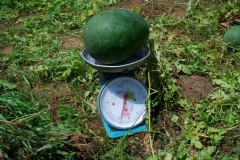
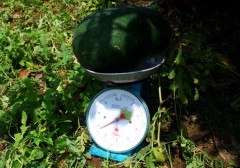
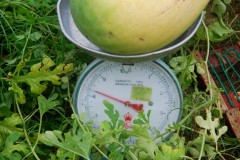
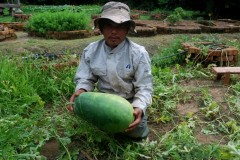
10:38 Posted in Blog | Permalink | Comments (0) | Tags: compost tea, bio nutrients, watermelon, organic fruits, organic farming
Apr 28, 2010
Outsmarting a wild boar...
Wild boar is a perpetual problem at our farm. They break through fencing and get at the chickens, they dig up all those lovely yams and sweet potatoes, they damage our vegetable plots digging up earthworms for desert.
All kinds of suggestions have been given to us; shoot them, poison them, trap them, etc. We reject outright killing. Trapping, etc never works; they're too wary.
Then they played with this beautiful pegaga patch and turned it into a mud-bath:
We were too distraught to remember to take a picture of the mud-bath.
We rehabilitated the patch twice but each time the pigs came in and turned it into mud again.
Then we sat and decided to think like a pig: it's dark, we can't look upwards to see the sky, we can only see directly in front, sideways and down. Now what if we see something totally dark in front would we be foolhardy enough to plunge ahead or would we move sideways looking for a path?
And we came up with this:
This was how the rehabilitated patch looked like after a week in the 'dark zone' (the red laterite mud has been topped with compost):
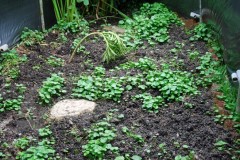
And this is signs of the pigs going in circles around the 'dark zone'. Note the mud!
And this is the patch today after two weeks. Warms the heart. The possibility are endless! And we don't have to take a life or lives to co-exist. Remember, a life is still a life.
18:47 Posted in Blog | Permalink | Comments (4) | Tags: wild boar, pigs, trapping a wild boar
Apr 23, 2010
Logging - Who Benefits? Part III
Today's Star:
One Citizen, One Tree:
http://thestar.com.my/news/story.asp?file=/2010/4/23/nati...
Council to plant a tree for every child born in Perak
http://thestar.com.my/news/story.asp?file=/2010/4/23/nati...
And lovely Sabah, home to Maliau, and what's left of the Orang Utan race:
http://thestar.com.my/news/story.asp?file=/2010/4/23/nation/6113557&sec=nation
Today Near The Farm:


Malaysians, please take note we are paying for all these tree planting. They are not for free.
Someone is cutting down 50 to 100 year old trees, clearing huge tracts of CO2 absorbing forests, destroying huge water catchment areas and laughing all the way to the bank. You know who these people are! (If you don't, FIND OUT!)
And we end up paying to plant trees, to pay for water pipelines from distant places, to pay for higher water rates, to pay for storms and flash floods, to pay for cooling as our cities become hotter. It is just not right.
This is what you can do for Earth Day:
Start by knowing who these tree cutters are! Here's a partial list.
And when they donate money for schools, reject their donation.
When they contribute to local houses of worship, return their money.
When they come with an entourage to open some park or building, or to plant a tree (yes, they have!) show your back to them.
When they give a lecture as a public figure or an opinion leader if you like, please throw your slippers at them! :)
Malaysians get your values right! These are not people to be emulated or honoured or respected.
10:51 Posted in Blog | Permalink | Comments (0) | Tags: logging, timber
Apr 13, 2010
Organic Farming - Oasis For Birds
An organic farm is like an oasis to birds. At our farm we have counted close to 50 species. Foreign workers at our farm comment that there's no longer any necessity to keep them in cages as they are all around us and we don't even have to feed or water them! That's a valuable lesson they will take back with them after they finish their contract with us.
And the birds lost most of their fear for humans. They will nest anywhere; next to the kitchen, on pillars, inside a comb of bananas, or like the photos here, on a dragon fruit plant in broad daylight in plain view of passer-bys and vehicles :
Right next to a ripened dragon fruit.
A couple of hatchlings in a meticulously weaved cup with tidy, even rim.
The bird that made this cup is the Pied Fantail or Rhipidura Javanica Longicauda.
In our farm, they have grown used to being in close proximity to humans, but remain wild as nobody in the farm is allowed to feed the birds.
The Pied Fantail is distinguished from other Fantails by pale underparts with a contrasting blackish breast-band.
When annoyed, it gives a chit, cheet sound to distract you from its nest.
It lays a clutch of 2 eggs and is common throughout South East Asia.
Mum's back.
Close up (click on picture) of the Pied Fantail. Note the breast-band, and the barely noticeable white eye-brow.
Here's why they are named Fantail (click on pic for close-up).
18:04 Posted in Blog | Permalink | Comments (0) | Tags: organic farming, sustainable agriculture, birding
Mar 25, 2010
Caviar of the East - Pavlovian Imprinting
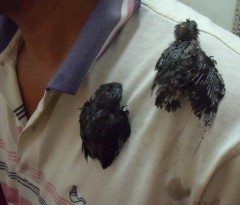
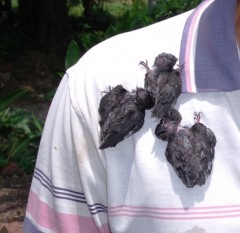
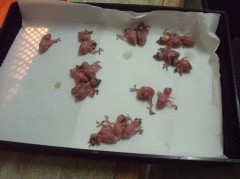
09:39 Posted in Blog | Permalink | Comments (1) | Tags: swiftlet farming, walit, walet, swiftlets, aerodramus fuciphagus, aerodramus maximus








